width BMW X3 3.0SI 2007 E83 Owner's Manual
[x] Cancel search | Manufacturer: BMW, Model Year: 2007, Model line: X3 3.0SI, Model: BMW X3 3.0SI 2007 E83Pages: 139, PDF Size: 4.74 MB
Page 83 of 139
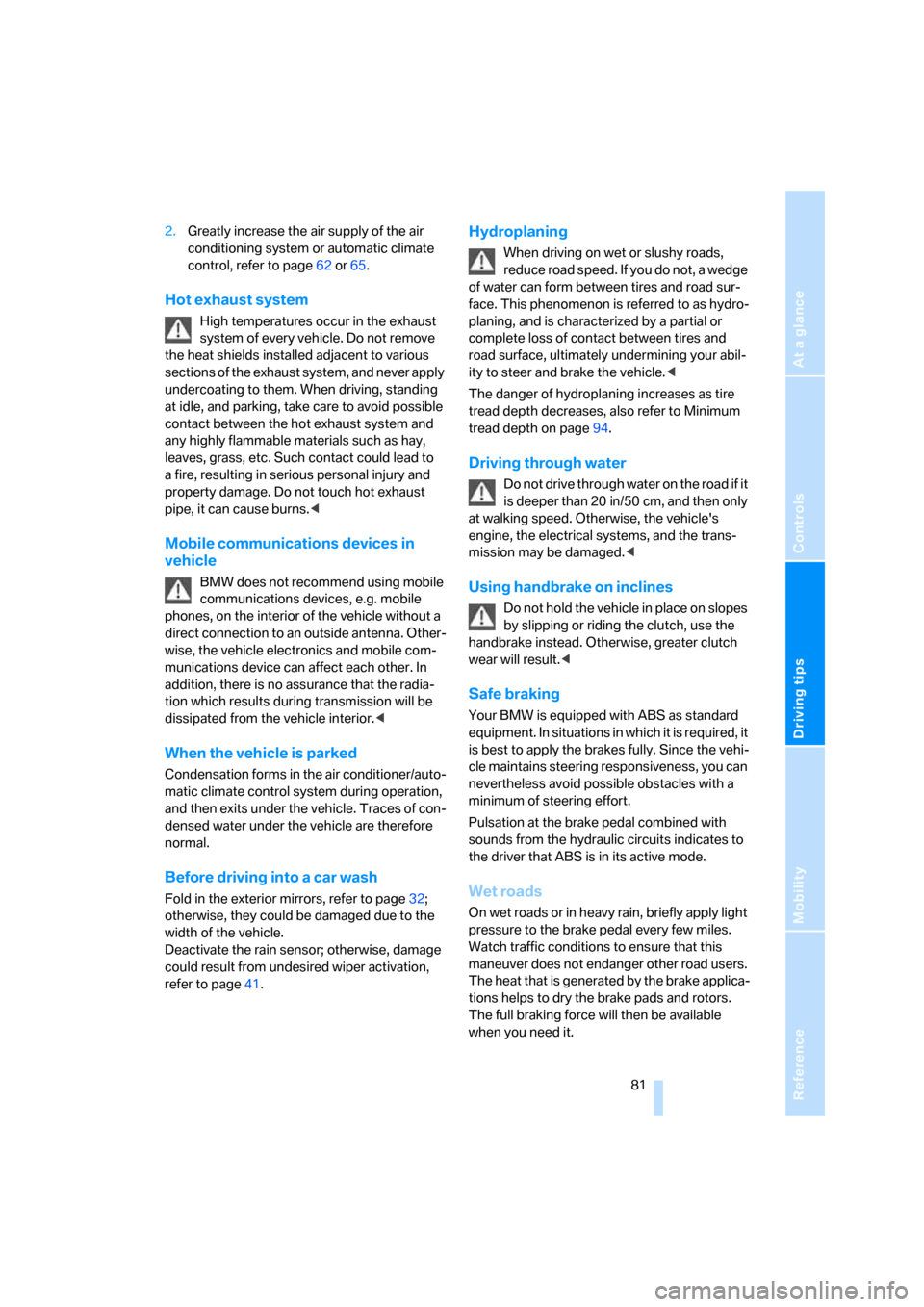
Reference
At a glance
Controls
Driving tips
Mobility
81
2.Greatly increase the air supply of the air
conditioning system or automatic climate
control, refer to page62 or65.
Hot exhaust system
High temperatures occur in the exhaust
system of every vehicle. Do not remove
the heat shields installed adjacent to various
sections of the exhaust system, and never apply
undercoating to them. When driving, standing
at idle, and parking, take care to avoid possible
contact between the hot exhaust system and
any highly flammable materials such as hay,
leaves, grass, etc. Such contact could lead to
a fire, resulting in serious personal injury and
property damage. Do not touch hot exhaust
pipe, it can cause burns.<
Mobile communications devices in
vehicle
BMW does not recommend using mobile
communications devices, e.g. mobile
phones, on the interior of the vehicle without a
direct connection to an outside antenna. Other-
wise, the vehicle electronics and mobile com-
munications device can affect each other. In
addition, there is no assurance that the radia-
tion which results during transmission will be
dissipated from the vehicle interior.<
When the vehicle is parked
Condensation forms in the air conditioner/auto-
matic climate control system during operation,
and then exits under the vehicle. Traces of con-
densed water under the vehicle are therefore
normal.
Before driving into a car wash
Fold in the exterior mirrors, refer to page32;
otherwise, they could be damaged due to the
width of the vehicle.
Deactivate the rain sensor; otherwise, damage
could result from undesired wiper activation,
refer to page41.
Hydroplaning
When driving on wet or slushy roads,
reduce road speed. If you do not, a wedge
of water can form between tires and road sur-
face. This phenomenon is referred to as hydro-
planing, and is characterized by a partial or
complete loss of contact between tires and
road surface, ultimately undermining your abil-
ity to steer and brake the vehicle.<
The danger of hydroplaning increases as tire
tread depth decreases, also refer to Minimum
tread depth on page94.
Driving through water
Do not drive through water on the road if it
is deeper than 20 in/50 cm, and then only
at walking speed. Otherwise, the vehicle's
engine, the electrical systems, and the trans-
mission may be damaged.<
Using handbrake on inclines
Do not hold the vehicle in place on slopes
by slipping or riding the clutch, use the
handbrake instead. Otherwise, greater clutch
wear will result.<
Safe braking
Your BMW is equipped with ABS as standard
equipment. In situations in which it is required, it
is best to apply the brakes fully. Since the vehi-
cle maintains steering responsiveness, you can
nevertheless avoid possible obstacles with a
minimum of steering effort.
Pulsation at the brake pedal combined with
sounds from the hydraulic circuits indicates to
the driver that ABS is in its active mode.
Wet roads
On wet roads or in heavy rain, briefly apply light
pressure to the brake pedal every few miles.
Watch traffic conditions to ensure that this
maneuver does not endanger other road users.
The heat that is generated by the brake applica-
tions helps to dry the brake pads and rotors.
The full braking force will then be available
when you need it.
Page 95 of 139
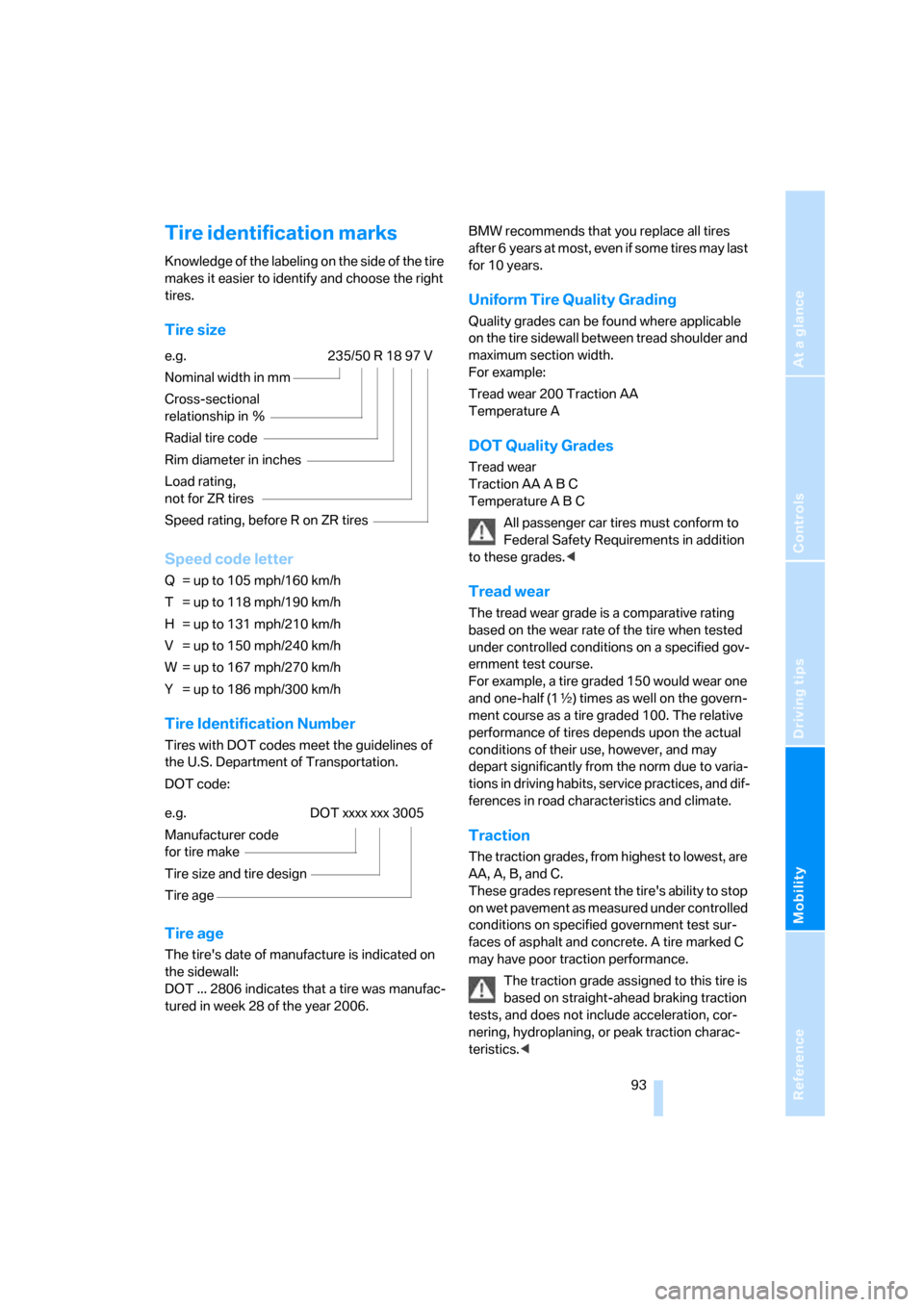
Reference
At a glance
Controls
Driving tips
Mobility
93
Tire identification marks
Knowledge of the labeling on the side of the tire
makes it easier to identify and choose the right
tires.
Tire size
Speed code letter
Q = up to 105 mph/160 km/h
T = up to 118 mph/190 km/h
H = up to 131 mph/210 km/h
V = up to 150 mph/240 km/h
W = up to 167 mph/270 km/h
Y = up to 186 mph/300 km/h
Tire Identification Number
Tires with DOT codes meet the guidelines of
the U.S. Department of Transportation.
DOT code:
Tire age
The tire's date of manufacture is indicated on
the sidewall:
DOT ... 2806 indicates that a tire was manufac-
tured in week 28 of the year 2006.BMW recommends that you replace all tires
after 6 years at most, even if some tires may last
for 10 years.
Uniform Tire Quality Grading
Quality grades can be found where applicable
on the tire sidewall between tread shoulder and
maximum section width.
For example:
Tread wear 200 Traction AA
Temperature A
DOT Quality Grades
Tread wear
Traction AA A B C
Temperature A B C
All passenger car tires must conform to
Federal Safety Requirements in addition
to these grades.<
Tread wear
The tread wear grade is a comparative rating
based on the wear rate of the tire when tested
under controlled conditions on a specified gov-
ernment test course.
For example, a tire graded 150 would wear one
and one-half (1γ) times as well on the govern-
ment course as a tire graded 100. The relative
performance of tires depends upon the actual
conditions of their use, however, and may
depart significantly from the norm due to varia-
tions in driving habits, service practices, and dif-
ferences in road characteristics and climate.
Traction
The traction grades, from highest to lowest, are
AA, A, B, and C.
These grades represent the tire's ability to stop
on wet pavement as measured under controlled
conditions on specified government test sur-
faces of asphalt and concrete. A tire marked C
may have poor traction performance.
The traction grade assigned to this tire is
based on straight-ahead braking traction
tests, and does not include acceleration, cor-
nering, hydroplaning, or peak traction charac-
teristics.< e.g. 235/50 R 18 97 V
Nominal width in mm
Cross-sectional
relationship in Ξ
Radial tire code
Rim diameter in inches
Load rating,
not for ZR tires
Speed rating, before R on ZR tires
e.g. DOT xxxx xxx 3005
Manufacturer code
for tire make
Tire size and tire design
Tire age
Page 111 of 139
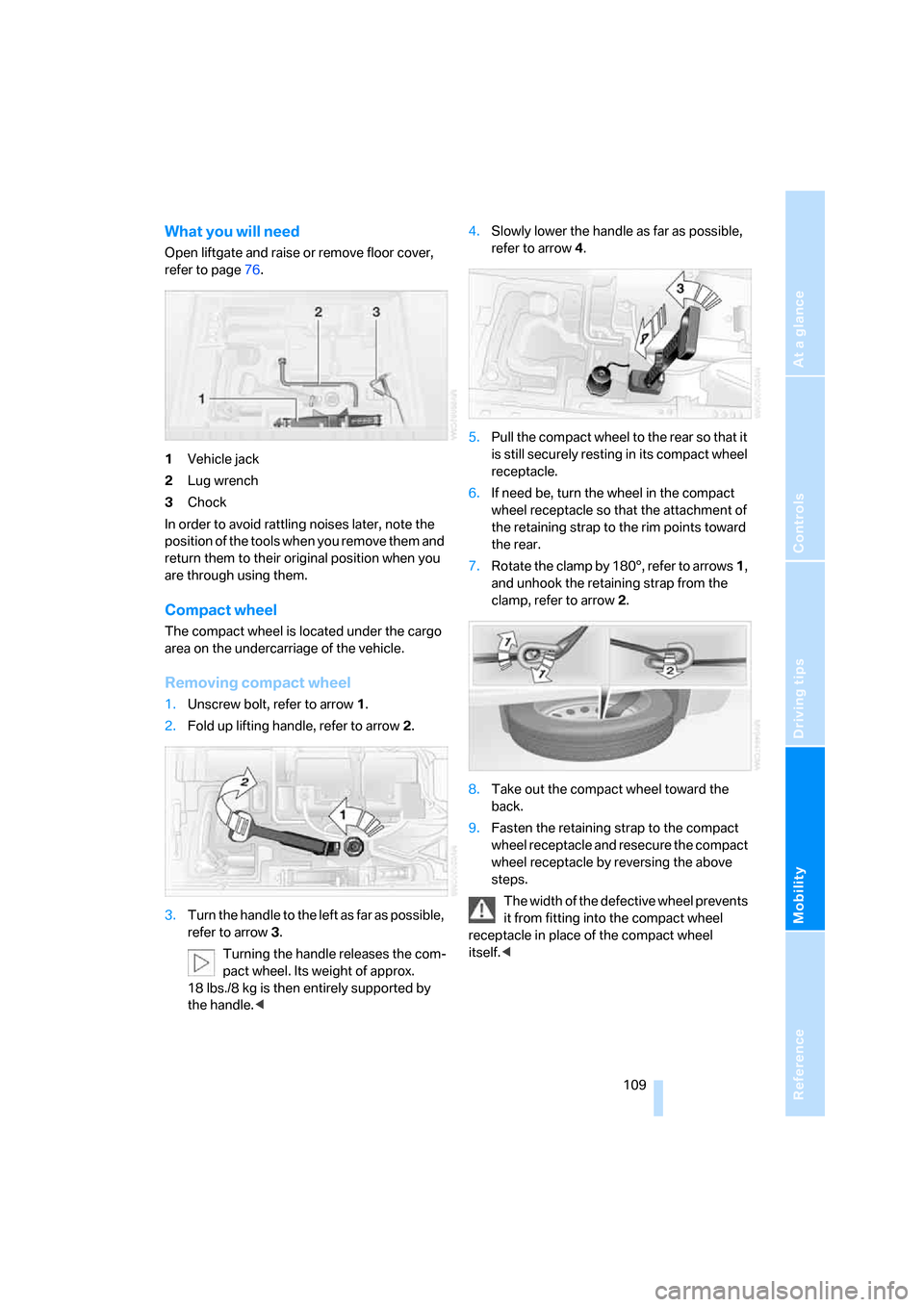
Reference
At a glance
Controls
Driving tips
Mobility
109
What you will need
Open liftgate and raise or remove floor cover,
refer to page76.
1Vehicle jack
2Lug wrench
3Chock
In order to avoid rattling noises later, note the
position of the tools when you remove them and
return them to their original position when you
are through using them.
Compact wheel
The compact wheel is located under the cargo
area on the undercarriage of the vehicle.
Removing compact wheel
1.Unscrew bolt, refer to arrow1.
2.Fold up lifting handle, refer to arrow2.
3.Turn the handle to the left as far as possible,
refer to arrow3.
Turning the handle releases the com-
pact wheel. Its weight of approx.
18 lbs./8 kg is then entirely supported by
the handle.<4.Slowly lower the handle as far as possible,
refer to arrow4.
5.Pull the compact wheel to the rear so that it
is still securely resting in its compact wheel
receptacle.
6.If need be, turn the wheel in the compact
wheel receptacle so that the attachment of
the retaining strap to the rim points toward
the rear.
7.Rotate the clamp by 180°, refer to arrows 1,
and unhook the retaining strap from the
clamp, refer to arrow 2.
8.Take out the compact wheel toward the
back.
9.Fasten the retaining strap to the compact
wheel receptacle and resecure the compact
wheel receptacle by reversing the above
steps.
The width of the defective wheel prevents
it from fitting into the compact wheel
receptacle in place of the compact wheel
itself.<
Page 135 of 139
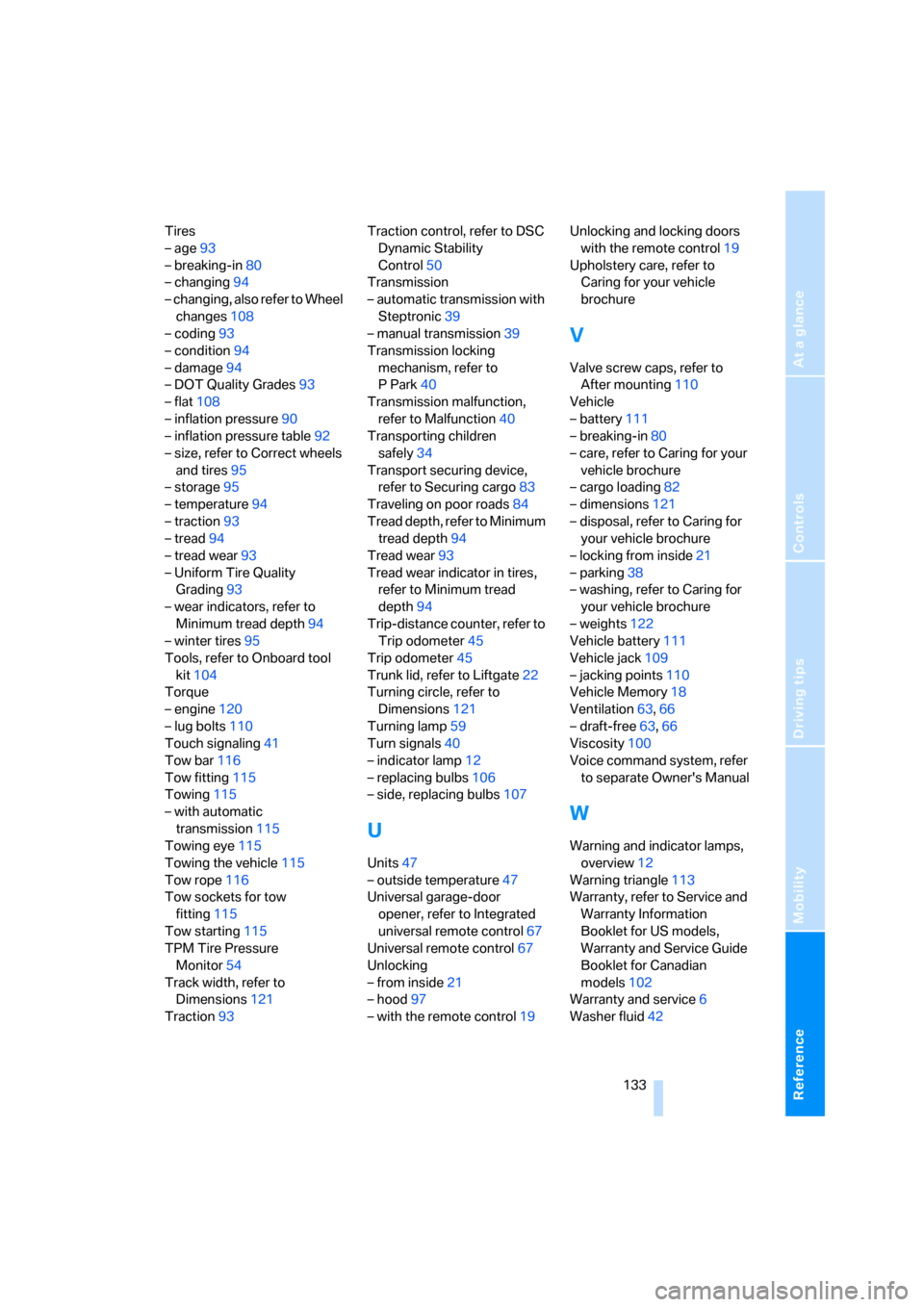
Reference
At a glance
Controls
Driving tips
Mobility
133
Tires
– age93
– breaking-in80
– changing94
– changing, also refer to Wheel
changes108
– coding93
– condition94
– damage94
– DOT Quality Grades93
– flat108
– inflation pressure90
– inflation pressure table92
– size, refer to Correct wheels
and tires95
– storage95
– temperature94
– traction93
– tread94
– tread wear93
– Uniform Tire Quality
Grading93
– wear indicators, refer to
Minimum tread depth94
– winter tires95
Tools, refer to Onboard tool
kit104
Torque
– engine120
– lug bolts110
Touch signaling41
Tow bar116
Tow fitting115
Towing115
– with automatic
transmission115
Towing eye115
Towing the vehicle115
Tow rope116
Tow sockets for tow
fitting115
Tow starting115
TPM Tire Pressure
Monitor54
Track width, refer to
Dimensions121
Traction93Traction control, refer to DSC
Dynamic Stability
Control50
Transmission
– automatic transmission with
Steptronic39
– manual transmission39
Transmission locking
mechanism, refer to
PPark40
Transmission malfunction,
refer to Malfunction40
Transporting children
safely
34
Transport securing device,
refer to Securing cargo83
Traveling on poor roads84
Tread depth, refer to Minimum
tread depth94
Tread wear93
Tread wear indicator in tires,
refer to Minimum tread
depth94
Trip-distance counter, refer to
Trip odometer45
Trip odometer45
Trunk lid, refer to Liftgate22
Turning circle, refer to
Dimensions121
Turning lamp59
Turn signals40
– indicator lamp12
– replacing bulbs106
– side, replacing bulbs107
U
Units47
– outside temperature47
Universal garage-door
opener, refer to Integrated
universal remote control67
Universal remote control67
Unlocking
– from inside21
– hood97
– with the remote control19Unlocking and locking doors
with the remote control19
Upholstery care, refer to
Caring for your vehicle
brochure
V
Valve screw caps, refer to
After mounting110
Vehicle
– battery111
– breaking-in80
– care, refer to Caring for your
vehicle brochure
– cargo loading82
– dimensions121
– disposal, refer to Caring for
your vehicle brochure
– locking from inside21
– parking38
– washing, refer to Caring for
your vehicle brochure
– weights122
Vehicle battery111
Vehicle jack109
– jacking points110
Vehicle Memory18
Ventilation63,66
– draft-free63,66
Viscosity100
Voice command system, refer
to separate Owner's Manual
W
Warning and indicator lamps,
overview12
Warning triangle113
Warranty, refer to Service and
Warranty Information
Booklet for US models,
Warranty and Service Guide
Booklet for Canadian
models102
Warranty and service6
Washer fluid42
Page 136 of 139
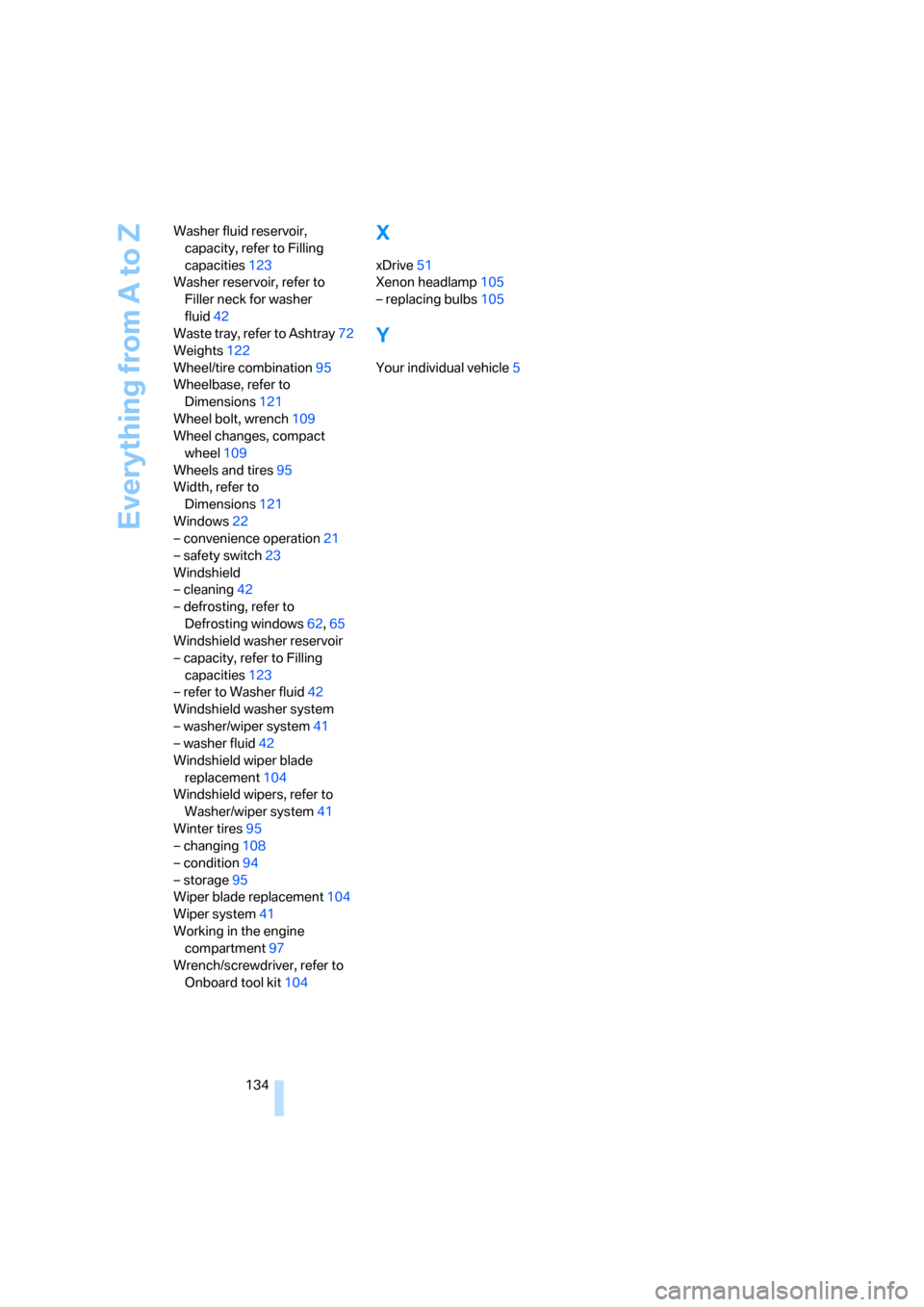
Everything from A to Z
134 Washer fluid reservoir,
capacity, refer to Filling
capacities123
Washer reservoir, refer to
Filler neck for washer
fluid42
Waste tray, refer to Ashtray72
Weights122
Wheel/tire combination95
Wheelbase, refer to
Dimensions121
Wheel bolt, wrench109
Wheel changes, compact
wheel109
Wheels and tires95
Width, refer to
Dimensions121
Windows22
– convenience operation21
– safety switch23
Windshield
– cleaning42
– defrosting, refer to
Defrosting windows62,65
Windshield washer reservoir
– capacity, refer to Filling
capacities123
– refer to Washer fluid42
Windshield washer system
– washer/wiper system41
– washer fluid42
Windshield wiper blade
replacement104
Windshield wipers, refer to
Washer/wiper system41
Winter tires95
– changing108
– condition94
– storage95
Wiper blade replacement104
Wiper system41
Working in the engine
compartment97
Wrench/screwdriver, refer to
Onboard tool kit104
X
xDrive51
Xenon headlamp105
– replacing bulbs105
Y
Your individual vehicle5